
EXTRACTS FROM AN OLD SCRAPBOOK
The mystery of the 'ha'penny gate'
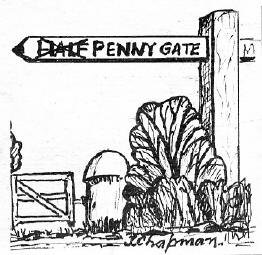 More
than a century ago it appears there was a toll-gate in the Broomhedge
district.
More
than a century ago it appears there was a toll-gate in the Broomhedge
district.
Known as the 'Ha'penny Gate' travellers were obliged to hand over the halfpenny before being allowed through.
Stories have it the money was used for the provision of a new bridge over the Lagan.
MAP
And these could be true for on an 1860 map the term 'New Bridge' is used.
This week Mr. John Chapman of 34 Castle Street, a local historian, visited the area but could find no trace of the gate even though he had his halfpenny with him.
PENNY GATE
Afterwards he quipped: "Perhaps as the halfpenny is no longer legal tender, I should have been looking for the 'Penny Gate.
And Mr. Chapman concluded: "If I had found the gate I wonder would it have been in order to wing on it on a Sunday?"
LOOKING BACK
50 Years ago
From the Lisburn Herald of April 13, 1918
D.C.M. Award----The Distinguished Conduct Medal for conspicuous bravery in the field of battle was awarded to Corporal (acting Sergeant) D. Boyd, R.E., Hillsborough.
Workhouse Closed---At the weekly meeting of Lisburn Board of Guardians, the Clerk, Mr. William Sinclair, reported that, accompanied by Mr. Crail and two Guardians, he had the inmates of the Workhouse transferred to Lurgan Workhouse. There were 20 paupers. _
Vestry --- The following appointments were made at the annual general
vestry meeting of Ballinderry Parish:--
Parochial nominators, Messrs. H. Walkington, E. Mockler and J. Beckett;
Supplemental nominators, Messrs. R. Beckett and R, Fleeton;
Synodsmen, Messrs. E.-Mockler, H. Walkington, 1. Tuft and R. Beckett;
Churchwardens, Messrs. H. Walking-ton and R. Beckett;
Select vestry, Messrs.. J. Beckett, R. Fleeton, W. 1. McCullagh, W. 1.
Fletcher, 1.. S. Taylor, 1. Tuft, E, Mockler. J. Bickerstaff, W. 1. .
Bell, S. Beckett, R. M. Mercer, R. Ferris.
Casualty -- Among war casualties reported was Brigadier-General H. T. Fulton, C.M.G., D.S.O., a son of the late Lieutenant-General John Fulton, who served in the Indian Mutiny, and a grandson of the late Major Robert Bell Fulton, Lisburn. He died of wounds.
ROLL OF HONOUR
IN Memoriam
SWANZY
To the proud memory of my brother Oswald Ross Swanzy, D. I., Royal Irish Constabulary, killed in lisburn, Sunday 22nd August, 1920, and of all his gallant comrades Officers and Men of the ROYAL IRISH CONSTABULARY, killed in the faithful performance of their duty 1919-1922.
Blow out you bugles, over the rich dead!
There's none of these so lonely and poor of old,
But, dying , has made us rarer gifts than gold.
These laid the world away; poured out the red
Sweet wine of youth; gave up the years to be
Of work and joy, and that unhoped serene,
That men call it age; and those who would have been
Their sons, they gave, their immortality
IN PASSING CATHEDRAL SPIRE.
The current issue of the Lisburn Cathedral Parish Magazine contains the following about the Cathedral Spire:- "The Cathedral spire has be in the centre of interest recently for the whole town, owing to the presence of steeplejacks. Like the other parts of the building it had reached such a state of deterioration that repairs could. not be postponed any longer.
The vane had ceased to function for several years, and the steeple jack who examined it found that the water was permeating the stone owing to its unsatisfactory condition ` It was also found that, the mortar between the stones of the spire had so worn away that the water was entering into the interstics and injuring the stonework. Hence the necessity of pointing the whole spire, The report was so alarming that it there was nothing left for the Vestry but to undertake: the work, especially as the ladders were in position. Postponement would have meant additional cost. We feel sure that all hope that we have now come to an end of these dilapidations." It is interesting to note, in passing, that. the vane has been in use for over one hundred years. A correspondent informs us that the height of the spire plus vane is 104 feet, the spire minus the vane being 94 feet, and the vane 10 feet.
The Hones of Linnwinny.
It was a warm day, writes a correspondent - an Antrim road that made me thirsty, and I turned into a roadside house for a draught of water, or, with luck, of buttermilk.
By the turf fire, one foot rocking a cradle, sat a young mother crooning a lullaby: -
Put your finger in the crow's nest,
The crow is not at home;
He is gone to Lurgan Town
To get a wee white stone.
She gave me my buttermilk, and I told her what the wee white stone was.
Lough Neagh was once a Wooded land-; by magic it was engulfed, or, rather, picked out bodily and thrown into the sea.
The Firbolgs put a false bottom to this lake, which was then known as the Pool of the Shubbery, or Linnwinny. This bottom had curious properties; for instance, a stick left seven. years in it became petrified.
Long long after, a trade in cutlery sprang, up in Lurgan, and some enterprising trader divined that hones were a corollary to such a trade. He put them on the market, and his itinerant travellers would advertise their wares with this doggerel ; .
"Lough Neagh hones, Lough Neagh hones;
You put them in sticks, and you take them out stones."
Miraculous virtue was attributed to these hones, and Lough Neagh or
Lurgan hones were sold Ireland over..
Goto Top
LISBURN LONG AGO
WHEN PROTESTANTS MARCHED TO MASS.
GREAT FIRE RECALLED. BUILDING THAT ESCAPED.
The picture showing the Lisburn and Lambeg Volunteers firing a feu de joie
in the Market Square, Lisburn, in honour of the Dungannon Convention, 1872
and presented to the Lisburn Urban Council by the Right Hon. Captain C. C.
Craig, now occupies a prominent position in the Council Chamber.
Lisburn contributed largely to the Volunteer forces of Ireland, and the, following is a more or less complete list of the companies raised locally :-Lisburn Light Infantry, Lisburn Grenadiers, Lisburn True Blues, Lisburn Fusiliers, Lambeg Infantry, Magheragall Infantry, Dunmurry Infantry, and Drumbo Rangers.
A striking instance of the union which at one time prevailed amongst the inhabitants is shown by the fact that on a certain Sunday the Lisburn Companies paraded in full dress and marched to Mass, where a sermon was preached by the Parish Priest and a hand some collection made to aid in defraying the debt on the Mass House, and we read that " large numbers of other Protestants attended." Unfortunately such a happy state of affairs was not destined to long continue, and later on the town was the scene of many a conflict. It was here that Henry Monro, one of the leaders of the Irish rebels, was publicly hanged in 1798; his head was afterwards hoisted on a pike in front of the Market. House and allowed to remain there for several, days. The picture gives an accurate appearance of the town in the latter part of the eighteenth century. The fine spire which now adorns the Cathedral was not added until 1807, but, the Market House dome remains the same. The building in front the only one that escaped the great fire which destroyed the town in 1707 is easily recognised as the present, fine drapery warehouse of George Duncan & Sons, Ltd. It was from one of the windows in this building that Monro was hanged.
WHEN RAISED.
The Irish Volunteers were raised shortly ;after the capture of Carrickfergus by Thur't, in 1760, for the purpose of repelling French invasion, the country being at the time denuded of regular troops. Their strength in 1782 was estimated at 100,000 men and 130 pieces of artillery but this is probably in excess of the actual numbers. The Commander in-Chief was the Earl of Charlemont, " The Glorious Man who led the van of the Irish Volunteers.
Delegates representing 34,000 Ulster Volunteers assembled at Dungannon on the 15th February, 1782, and resolved:-" That the Kings, Lords and Commons of Ireland alone had the right to make laws to bind this Kingdom." This resolution was confirmed by the Irish Parliament on the 16th April, 1782.
On the 10th November, 1783, 160 delegates, representing the Volunteers
of all Ireland, met in Dublin. Dissensions prevailed, and on the 1st
December the Convention was ad never to meet again. From that time the
body declined, and in 1793, after the reorganisation of the Irish Militia,
the assembling of armed bodies within Belfast and the several districts
adjacent thereto was prohibited and the Volunteers ceased to parade.
Goto Top
WHEN IT SNOWED JACK THE MILKMAN PULLED THE SLEIGH
HIMSELF
Ulster Star
6/07/1968
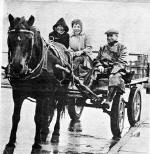 Years
ago men were measured by the way they looked after their horse.
Years
ago men were measured by the way they looked after their horse.
That puts Lisburn-born Jack McMaster among the best - even today - for every morning he's up at 4.30 to give Molly her breakfast before he takes his own.
Jack and his mare, Molly, aren't strangers to most Lisburn people. Between them they deliver 480 pints of milk a day in the town.
Molly has been pulling the milk-cart for four years now but her master has had a hold of the reins for over 30. Despite the mare's comparative newness to the round Jack says she does half of it herself.
For Molly knows every stop and turn along the route that begins not far from Jack's home at Low Road, through the estates and across town as far as Knockmore.
It's a tough job for both. And the only holiday Jack has had in 30 years was spent in hospital.
"But," he says, "I enjoyed the rest."
The round doesn't get any easier in winter. In fact, during heavy snows several years ago Jack decided it was a bit much for his horse, so he borrowed a sleigh and with the help of some strong lads, pulled it himself.
The shipyard clowns
Ulster Star
8/02/1988
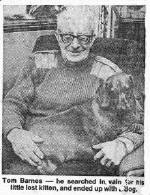
Tom Barnes will soon be 80, but as he sat in front of a blazing fire in his neat home at Aghalee Road, he '' remembered " as if it was yesterday," when he began work as a farm labourer - and of his 19 years in `Belfast shipyard.
He told me, among other things, that his first week's wages on the farm amounted to six shillings.
Tom said: "The food wasn't included, and you worked seven days a week from seven in the morning till six at night. When it was hay-time you worked till dark, and didn't get an extra ha'penny."
His last job before retiring was at the Yard, and he keeps in touch with some of his former Belfast workmates.
He recalled with a broad grin: "There was always something to give you a laugh in the shipyard. Some of them were real clowns, you know.
"One of the managers once said he had almost a full circus: he had the clowns, he had the monkeys, but he had no elephants.
"I remember too, the workers used to go across the dock to get to York Street in a ferry. And the manager said that if it sank, none of them would be drowned, because they had as much timber under their arms for firelights as would have kept them afloat."
Tom told a few yarns too, about the Bulky's - which was the nickname for the shipyard security police.
It was then that the little dog jumped up on his knee.
Patsy's a great companion," he said. I got it about four years ago after I lost my wee kitten - that - made me sad. I searched the fields for to enough but never found it.
"A friend knew I was annoyed, and asked me if would like a dog. I said would, but the man who owned it was looking £70 My friend said I couldn't afford that, so he cut it down to £35 - and then when he heard I was a pensioner, he let me have it f £17. I wouldn't take £200 for it."
Obituary.
Last member of Lisburn family
MISS Beatrice Barbour Simpson, of 1 Abercorn, Antrim Road, Lisburn, who died on Sunday, was the last surviving member of an old Lisburn family.
She was a daughter of the late Mr. and Mrs. David Barbour Simpson, North Circular Road, Lisburn.
Mr. Simpson, who died on October 29; 1961, had been a well-known member of the legal profession, his firm being D. B. Simpson and Company, Castle Street.
The firm is now incorporated with John T. McConnell and Son.
Miss Simpson had been a keen golfer. She joined the Lisburn club in 1933 and in 1955 was captain of the ladies' branch.
TENNIS
Incidentally, her mother, Mrs. Agnes Simpson, who died on April 28,1958, was captain in 1912 and 1927.
Miss Simpson's sister, Mrs. Joy Stockman, was captain in 1936. She died in December 1979.
Miss Simpson had been a keen tennis player, being associated with the Hilden club and also played badminton.
She took a keen interest in birds and was a member of the Lisburn group of the Royal Society for the Protection of Birds. Her cousin, Miss Jill Lowry, of 16 North Circular Road, Lisburn, is the group leader.
Miss Simpson also took a great interest in dogs.
CHURCH
She was a member of Railway Street Presbyterian Church and her father had served on the committee.
The funeral, which was private, took place on Wednesday morning to Lisburn Cemetery on the Hillsborough Road, the services in the home and at the graveside being conducted by the Very Reverend Dr. Howard Cromie, minister of the Railway Street congregation.
Houses of law and marketing
BY NOEL CONNELL
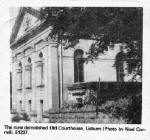 |
| The now demolished Old Courthouse, Lisburn (Photo by Noel Connell). E1207 |
There was a time when every town in Ulster looked on its market house, courthouse or townhall as one of its top status symbols. Not without reason either, for some of them were the realisation of top architects and the best of local craftsmanship.
Lisburn's recently demolished Courthouse was one of the most striking examples of such a local landmark. Built in 1883 at a cost of £4,000, it was built in a typical Victorian style.
Armagh, of course, with its late Georgian Courthouse built in 1809, was a classic example of not only good taste in architecture but good sense in using local raw material. Limestone from the Armagh quarries gave a more varied finish to the premises than the usual imported Portland stone.
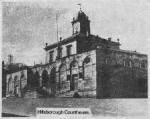 Hillsborough
Courthouse, built in the late eighteenth century is another
good example of the skilful blend of local materials. The
lower part of the building is of Mourne granite, quarried 25
miles away, and the middle courses are of North Down Scrabo
sandstone.
Hillsborough
Courthouse, built in the late eighteenth century is another
good example of the skilful blend of local materials. The
lower part of the building is of Mourne granite, quarried 25
miles away, and the middle courses are of North Down Scrabo
sandstone.
Typical of a style of civic design found in many Ulster
towns that reflects the individual character of the province,
I find it well worth a second glance.
Goto Top
Top council post for local man
LISBURN'S Assistant Town Clerk, Mr. George McGowan, of Coolsara Park, was appointed Town Clerk of Portadown 50 years ago this month.
A son of Mr. and Mrs. Alexander McGowan, Hillsborough Road, Lisburn, Mr. McGowan was born on December 16, 1905.
He entered the service of Lisburn Urban Council on March 8, 1920 as a junior clerk in the Town Clerk's office.
On the completion of his apprenticeship in 1925 he was appointed second assistant to the Town Clerk, a post he occupied until June 1934 when he was promoted Assistant Town Clerk in succession to Mr. Thomas H. MacDonald, who took over the Town Clerkship on the retirement of Mr. Thomas M. Wilson.
DEBATING
Mr. McGowan was a member of the Lisburn Choral and Orchestral Society and the Lisburn Technical School Amateur Dramatic Society.
He took a keen interest in the work of the Church Lads' Brigade.
Joining the Christ Church, Lisburn, Company as a boy, he rose to the rank of lieutenant and for many years was one of the principal organisers of the annual camp in England.
He was a member of South Antrim Hockey Club and a former captain of the Second Eleven.
Mr. McGowan was a member of the Orange and Masonic Orders.
DR. Brian Maginess, Barrister, Avonmore Lodge, Hillsborough Road, Lisburn, was chosen as the Official Unionist candidate for the Iveagh Division in the Northern Ireland Parliament at Stormont at a meeting of over 200 delegates in Dromore Orange Hall 50 years ago this month.
He received 106 votes with Dr. J. C. Wilson, the retiring member, receiving 83 votes and Mr. John F. McConnell, auditor and accountant and secretary of the Hauliers' Association, 18 votes.
PROPOSED
Dr. Maginess was proposed by Mr. George Baillie, Moira and seconded by Mr. Henry Bell, Hillsborough.
Dr. Wilson was proposed by Mr. William Lidde Donacloney and seconded by Mr. Kennedy McCormick, Lurganville.
Mr. McConnell was proposed by Mr. H. P. Watson and seconded by Mrs. Woods, Gilford.
Dr. Maginess, 37, was the second son of the late Mr. William George Maginess, solicitor, of Hillsborough and Lisburn
He received his early education at Downshire Public Elementary Schc Hillsborough and was c ed to the Bar in 1922.
He took a keen interest in sport, being a member of Hilsborough Cricket Club and Lisburn Golf Cub.
Dr. Maginess had a distinguished Parliamentary career with Ministerial, appointments.
Barbour heir killed in crash.
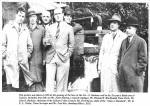 MR. JOHN Milne Barbour, a director of William Babour and Sons Limited
Lisburn, who was killed in an air crash at Johnston, Renfrewshire,
Scotland, on July 3, 1937, left personal estate valued at £408,465,
duty paid £75,661, it was announced 50 years ago this' month.
MR. JOHN Milne Barbour, a director of William Babour and Sons Limited
Lisburn, who was killed in an air crash at Johnston, Renfrewshire,
Scotland, on July 3, 1937, left personal estate valued at £408,465,
duty paid £75,661, it was announced 50 years ago this' month.
Mr. Barbour, 31, was the only son of the Right Honourable J. Milne Barbour, Dunmurry, Minister of Commerce.
He was a member of the Scottish Aero Club and took part in the King's Cup race in 1935.
Lisburn's first lorry
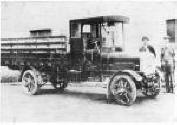
It was originally purchased by J. McCahey and Sons Motor Engineers of Graham Gardens and sold to local man Mr. W. H. Quinn. Mr..McCahey was the buyer of Lisburn's first two lorries. The other one was bought by a Mr. G. H. Bell of Hillsborough.
Taken outside the garage in Graham Gardens in 1910, features Mr.
W. H. Quinn (left) and Mr. J. McCahey. Does anyone remember who
bought the first car? E1115.
The dear little shamrock....'
LISBURN folk planning to send shamrock to their friends in America 50 years ago this month in time for St. Patrick's Day were advised that the American authorities would not allow the entry of shamrock unless the roots were washed and the plants and packing materials were entirely free from soil, or unless the leaves were cut and forwarded in suitable moist sphagnum or preservative.
Cricket, Club officers 50 years ago.(1938)
MR. George M. Crothers, captain and honorary secretary, presided at the annual meeting of Lisburn Cricket Club in the Temperance Institute 50 years ago this month.
The Right Honourable J. Milne Barbour was re-elected Patron and Mr. James Lowry was elected President in succession to the late Mr. Nelson Russell, who had held the office since 1913.
OFFICERS
Other appointments included: Honorary treasurer, Mr. A. E.
Hunter; assistant treasurer, Mr. J. Corken; honorary secretary, Mr.
F. A. Blaney; assistant secretary, Mr. Crothers.
Captain 1st XI, Mr. J. McCartney; vice-captain, Mr. Crothers;
captain 2nd XI, Mr. Hunter; vicecaptain, Mr. J. McMaster; captain
3rd X1, Mr. William Waring; honorary match secretary, Mr. S. Finlay;
representatives to the Northern Cricket Union, Mr. R. C. Bannister
and Mr. G. W. Bannister.
Junior representative to the NCU, Mr. A. E. Hunter; honorary auditors, Mr. J. L. Barclay and Mr. R. C. Newell; working committee, the officers and Messrs R. C. Bannister, G. W. Bannister, A N. Stevenson, E. G. Abbott, J L. Barclay and R. C. Newell.
A station worth stopping at
LISBURN'S Victorian railway station is the only Northern building to receive a European Architectural Heritage Year award for restoration work done over the past year by the Northern Ireland Railway works and building department. All the station's brick and stonework has been cleaned and the woodwork and Victorian iron work repaired and repainted.
Glazed canopies stained by steam and smoke have been completely renovated, the existing facilities have been extended and the station reorganised without prejudice to its Victorian character. The only addition has been the planting of some trees in the forecourt.
The station master, Mr. John Flavelle, said yesterday that he was not surprised his station had won the award. The roof was the original 1880 one and the Victorian ironwork was untouched. He had been nervous of its prospects of survival recently when a bomb planted near it was defused by British Army experts. The Lurgan station, with a similar design to Lisburn, had been badly damaged by an explosion.
Mr. Charles Brett, chairman of the Ulster Architectural Heritage Society, called the award splendid news and praised the work done at Lisburn. It was a pity that Northern Ireland Railways had, not been able to preserve Troopers Lane station, near Carrickfergus, and he hoped they would do some-thing about Portrush and Helen's Bay now.
Silver salver for council chief
MR. George McGowan, the new Town Clerk of Portadown and formerly Assistant Town Clerk of Lisburn, was back in Lisburn 50 years ago this month.
At a ceremony in the Temperance Institute Lisburn Urban Council officials presented him with a suitably inscribed silver salver.
The gift was handed over by Mr. John D. Barbour, former chairman of the council.
Mr. Thomas H. MacDonald, Town Clerk, who presided, said Mr. McGowan had entered the service of the Lisburn Council by competitive examination in March 1920 and before he reached his fifteenth birthday.
Tributes were paid to Mr. McGowan by Mr. MacDonald, Mr. Barbour,
Dr. E. I. May Ouin, Medical Officer of Health, Mr. R. E. L. Clarke,
Town Surveyor, Mr. Fred Kee, Sub Sanitary Officer, Mr. A. S. Brook,
Gas Manager, Mr. Thomas Waring, Rate Collector and Captain Walter
Tyler, Gas Accountant.
Goto Top
Barnardo 'Musical Boys'
Ulster Star 11/11/1988
THE famous Barnardo Musical Boys visited Lisburn 50 years ago this month and gave an enjoyable evening's entertainment in First Lisburn Presbyterian Church Hall.
The boys gave a number of items on the handbells and "Highland Melodies " and " Empire Echoes " on the sleigh bells.
The programme also included items on three bagpipes, mandolins, xylophones, marimbaphones, fairy bells, etc.
The accompaniments were played by Mr. E. Huskisson, musical instructor.
The Right Honourable J. Milne Barbour, DL, MP, Minister of Commerce, who presided, said wonderful work had been carried on by the Barnardo Homes for a little over 70 years.
It was not only the children of neglectful parents that that great cause helped, but the children of parents, perhaps the kindest parents in the world, who were taken from their infants at an early age, the children being left without friends or caretakers in the world.
Mr. W. Orr, Northern Ireland Organiser, thanked everyone who had helped in connection with the concert.
The local arrangements in connection with the entertainment were carried out by Miss Sache Kidd.
New minister for Railway
Street
Ulster Star 11/11/1988
RAILWAY Street Presbyterian Church, Lisburn, congregation 50 years ago this month made out a call in favour of the Reverend John Knox Elliott, First Islandmagee, in succession to the Reverend T. H. Robinson, who was appointed to a Professorship in Magee University College, Londonderry.
Mr. James Boyd, Clerk of Session, announced the unanimous selection of the commission appointed to hear ministers and Mr. Elliott's nomination was proposed by Mr. George Duncan and seconded by Mr. William Bowden.
Mr. Elliott was a son of Mrs. Elliott and the late Mr. Robert Elliott of the Ballyclare district.
He graduated at Queen's University, Belfast and took Honours in English Literature.
A licentiate of Carrickfergus Presbytery, he held the Magill Bursary in the Assembly's College, Belfast and was a prize-man for three successive years.
ASSISTANT
He was for a period assistant to the Reverend Richard Hall in Megain Memorial Church, Belfast.
In April 1929 he was ordained to the ministry as colleague and successor to the Reverend D. Steen in First Islandmagee.
Mr. Elliott took a keen interest in youth work and was convenor of the General Assembly's Youth Guild Committee.
He married a daughter of the late Reverend Dr. Charles Davey of Fisherwick Church, Belfast and when he came to Lisburn they had two little sons.
Triumph Templar Lodge officers
Ulster Star 11/11/1988
Mr. S. Roberts, PCT, conducted the election of officers of Triumph Lodge No. 33 in the Good Templar Hall, Linenhall Street, Lisburn, 50 years ago this month.
They included CT, Mr. S. Allen; VT, Mr. Buchanan; secretary, Mr. McCoy; PCI and treasurer, Mr. S. Roberts; financial secretary, Mr. J. Troy; chaplain, Mr. Carson; guard, Mr. Alderdice; sentinel, Mr. Boyd.
Happiness and hard work in India
Lisburn man Herbert Pritchard met his wife in the strangest of places and not the most comfortable circumstances.
As a young man he travelled to India, as a Christian missionary.
And there in. the hills of Bihar, close to the India-Nepal border, he net a. girl from Preston engaged in the same line of work as himself.
Her name was Elizabeth. And not too long afterwards she became Mrs. Pritchard.
The setting for their wedding must have beer beautiful. But in India the scenery can camouflage the uglier aspect: of life.
There was acute suffering anion g the people of Bihar and one of the main crippling agents was no more vicious a disease than leprosy.
So although neither of them was medically qualified, Mr. and 'Mrs. Pritchard decided to fulfil their roles as members, of the Regions Beyond Missionary Union by not only looking to the Indians' spiritual needs, but caring for their physical needs.
They began to treat the sick, and care for the abandoned or orphaned.
Their work progressed from small beginnings until last year, the husband and wife team were the superintendents of a leprosy 'hospital' in Bihar.
Now a year later, they are retired from the missionary work and are back home. in Lisburn.
But although after their long stint in India it may have been thought, that the couple needed a rest. they haven't stopped working
Mr. Pritchard has become RBMU secretary in Northern Ireland. and as such has organised the Union's centenary celebrations here.
Entitled "For Such Tinge." the book is published by Victory Press, and sells at 50.p.
